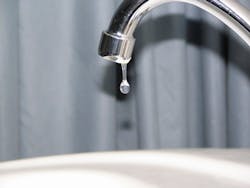Aqua America Launches Lead Poisoning Prevention Week
Aqua America launched Lead Poisoning Prevention Week Oct. 23 to 29 to educate the public about the importance of detecting lead in drinking water. The company wants customers to be informed about the health risks of lead exposure and understand how they can ensure their drinking water is safe.
There are two potential sources of lead contamination in drinking water: lead service line that delivers water directly into homes from the water main in the street and household plumbing containing lead solder and brass fixtures. Contrary to popular belief, lead is not typically found in streams, reservoirs or wells that supply water to homes.
“Lead Poisoning Prevention Week provides a great opportunity to increase awareness about the dangers of lead exposure and make sure our customers understand the importance of checking their home for lead sources,” said Christopher Crockett, Ph.D., chief environmental officer for Aqua America.
Aqua America conducts required testing for drinking water contaminants, including lead and copper, to ensure compliance with state and federal drinking water standards. The company also treats corrosive water with a corrosion inhibitor to decrease the rate of lead that leaches into water from pipes and fixtures.
In addition, the company tests for lead in high-risk sample homes to comply with the U.S. Environmental Protection Agency’s (EPA) Lead and Copper Rule. As standard practice, it replaces their portion of any lead service line if found during maintenance and construction activities. If Aqua America finds lead in the portion of the service line owned by the customer, they strongly encourage the customer to replace it.
If a customer’s water shows elevated levels of lead, or if the customer is concerned about the potential of lead in his or her water, Aqua America suggests the following steps to minimize exposure:
- Run your tap to flush out lead. If your water has not been used for several hours, run water for at least 30 seconds or until it becomes cold or reaches a steady temperature before using it for drinking or cooking.
- Use cold water to cook and prepare baby formula. Do not boil water to reduce lead. Lead dissolves more easily into hot water; boiling water will not reduce lead.
- If you buy a water filter, make sure it is approved to reduce lead. You can contact NSF Intl. at 800.673.8010 or www.nsf.org to learn more about approved water filters.
- Be aware that brass faucets, fittings and valves—even those advertised as lead-free—might contribute lead to drinking water. The law allows end-use fixtures, such as faucets, with wetted surfaces containing a maximum weighted average of 0.25% lead to be labeled as lead-free.
- If you are concerned about exposure, contact your local health department or healthcare provider to find out how you can get tested for lead.
For more information on reducing lead exposure in your home, visit www.aquaamerica.com. Aqua America customers also can call the company at 877.987.2782 for information about having their water tested for lead.
Source: Aqua America
